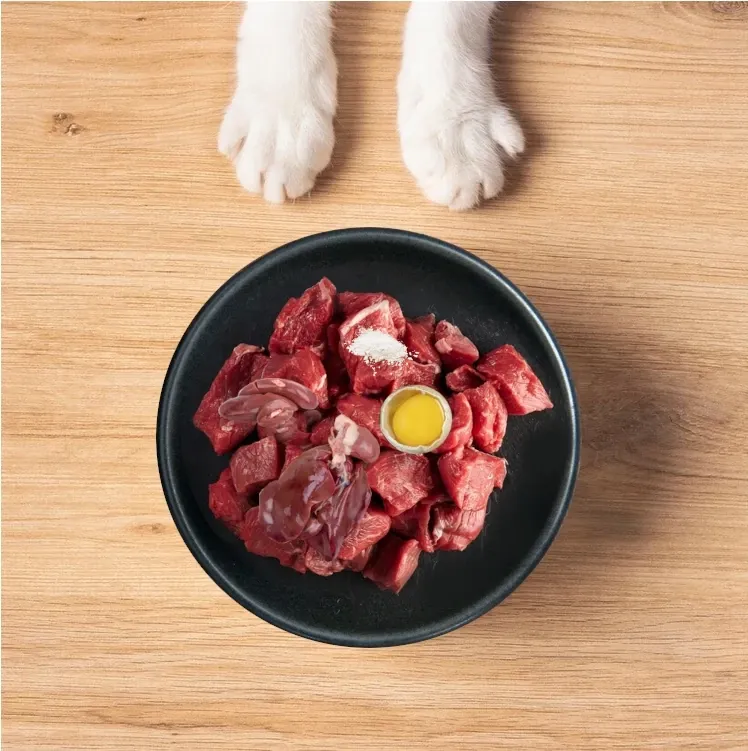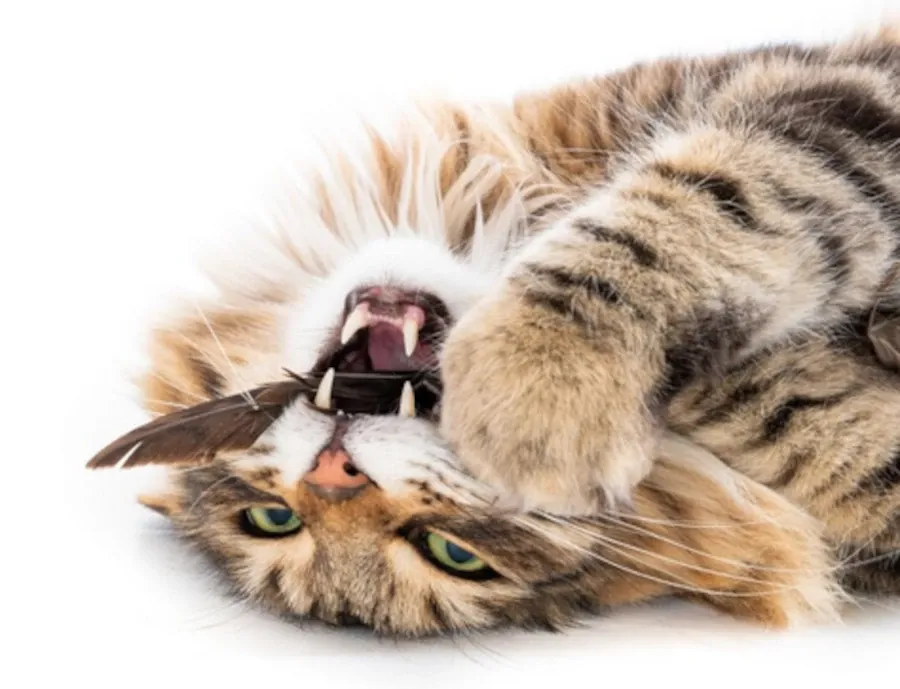The Top Benefits of Raw Feeding Your Cat (Part 2)
The top most notable benefits of raw feeding cats are looked at, which forms Part 2 of this compelling 2-part discussion. Nutritional benefits, disease reversal and digestive benefits were focused on in Part 1. This post adds two more very important, equally impressive benefits.

This two-part discussion looks at the five top-most benefits of raw feeding your cat. Part 1 looked at the first three points, whereas this post discusses two more important points to round it up.
#4 More effective immune function
The highly processed, carnivore inappropriate and poorly digested ingredients in commercial cat foods are often at the centre of food intolerance and allergies in cats.
...immune triggers
For instance, high-heat processed proteins in commercial foods are less digestible and their molecular shape is distorted by heat application 1.
These abnormal proteins are often the root cause of food allergies in cats. The immune system views these unfamiliar and unnatural molecules as invaders and responds to them with sustained attack responses 1.
Furthermore, poorly absorbed and synthetic food particles 2 are similarly viewed by the immune system as abnormal, foreign invaders. They also cause pathological immune responses and subsequent damage to surrounding cells and tissues.
...a losing battle
When the cat’s immune system is tied up in ‘fighting’ these perceived ‘invaders’, actual threats can easily slip past the immune system undetected, leaving cats open to infection and disease.
These constant immune responses burden the cat’s immune system and often-times progress to serious autoimmune diseases 3.
...correcting system functioning
Balanced raw feeding removes common allergens and carnivore inappropriate ingredients from the diet, which immediately calms the immune system and resultant inflammation.
When the immune system is less tied up by misguided attacks on misidentified ‘invaders’, it can more effectively detect and eliminate real threats, like bacteria, viruses and parasites.
Dr Pollak (DVM) remarked that, in his medical opinion, the raw diet enabled the immune system of chronically ill pets to finally overcome and shrug off lingering or chronic disease 4.
#5 Improved dental health
Even though commercial pet food manufacturers overtly claim many dental benefits from consumption of their foods, these claims are bogus.
Neither kibble, nor canned cat food will keep teeth clean and the oral cavity in good shape, no matter what they state. These food textures are simply not challenging enough.
...lack of food texture
In fact, commercial foods are mostly responsible for the rapid oral decline seen in house cats 5. Nature works on a “use it or lose it” principle.
If teeth and jaw muscles are not used in the intended way, jaw muscles atrophy and cats eventually start to lose teeth.
...correct prehension and vigourous chewing required
Only tearing meat, crunching bones and snipping through connective tissue can prevent jaw muscle weakening and dental decline 5, 6.

Importantly, many raw feeders prefer to feed ground raw foods without realising that this food texture is also not challenging enough.
Ground foods will not offer the same level of oral conditioning as tearing meat chunks and crushing small raw bone-in cuts.
...a straightforward process
Commercial cat foods have long been known to promote bad microbial overgrowth in the mouth 5.
This allows for copious amounts of plaque and tartar to form while the sugars and starches in these foods further advance tooth decay.
For decades now, periodontal disease in cats has also been strongly associated with consumption of foods that do not involve gripping, tearing and vigorous chewing 7.
The lack of friction on the tooth’s surface allows for plaque and tartar to accumulate unabated.
This kind of build-up is quickly followed by gingivitis – inflammation and redness of the gums 8.
...predictable outcomes
Build-up and gingivits rapidly advance to periodontitis, characterised by the destruction of tooth supporting and anchoring structures and surrounding bone.
Finally, this process ends in pain, an inability to eat and tooth loss 9. Notably, underlying periodontal disease is often a central cause of stomatitis – another common and painful inflammatory condition of the gums and mouth 10.
...oral health is tied to overall health
A healthy mouth is vitally important to the overall health and well-being of any animal 6. For one, oral health is a prerequisite for survival 11.
The levels of oral decay seen in house cats are abnormal and rarely seen in their wild natives. More importantly, chronic mouth infection can readily spread to organs, causing their degeneration and disease 9.
With periodontal disease there is a marked suppression of white blood cells that signifies poor overall health 5.
...raw food can prevent or correct these issues
Cat-appropriate raw meaty bones and even chunks or strips of meat 7 act as nature's toothbrushes that scrape the teeth clean and massage gums into good health 12.
Blood flow to the entire mouth is improved, which promotes good gingival and oral health 7. Correct eating conditions the jaw muscles and offers protection against periodontal-related stomatitis.
And these assertions were supported decades ago already by an independent review of the literature commissioned by the Australian Veterinary Association 7.
The correct dietary changes spur improved oral health, which in turn spurs a dramatic rise in leukocytes 5. The rise in leukocytes confirms the systematic restoration of overall health.
...but more may be required
Raw feeding can do a lot to reverse poor oral health. But Dr Lisa Pierson (DVM) offers a more realistic word of caution.
If cats have been consuming commercial cat food – especially kibble – for many years, raw food alone might not be able to completely reverse this kind of excessive build-up or advanced levels of periodontitis 13.
More might be needed to restore oral health. A cleaning under anaesthesia might unfortunately be required to give severely affected cats a good start, after which raw meat chunks and cat appropriate raw meaty bones will keep the mouth in good order going forward.
...prevention is always better than cure
Of course, raw feeding from a young enough age can prevent the levels of oral decline seen in cats consuming inappropriate, ultra processed cat foods.
Finally, only the top five most prominent benefits were focused on. There are many more benefits that follow from biologically appropriate feeding that will be systematically covered by future raw feeding posts.


References
1 Hofve, J. (2013). 10 Reasons why dry food is bad for cats & dogs. In Little Big Cat. Retrieved August 08, 2024, from https://littlebigcat.com/why-dry-food-is-bad-for-cats-and-dogs/
2 Clement, B.R. (2010). Supplements Exposed: The truth they don't want you to know about vitamins, minerals, and their effects on your health. Franklin Lakes, New Jersey: New Page Books.
3 Raw Feeding for IDB Cats (n.d.). What is feline inflammatory bowel disease? Retrieved August 19, 2024, from http://www.rawfeedingfor ibdcats.org/what-is-feline-ibd.html
4 Pollak, W. (2003). Elimination of common diseases in dogs and cats through diet alone. In Fairfield Animal Hospital. Retrieved August 16, 2024, from https://drive.google.com/file/d/1pVBSekADqOWzXci0_AYVm1g_qr6DWyvp/view
5 Lonsdale, T. (1995). Periodontal disease and leucopenia. Journal of Small Animal Practice, 36(12), 542-546.
6 Zurich, L. (2010). Raw fed cats: Feeding cats a diet of whole raw foods based on nature's model, an illustrated companion guide. Self-published Ebook.
7 Watson, A.D.J. (1994). Diet and periodontal disease in dogs and cats. Australian Veterinary Journal, 71(10), 313 – 318.
8 Clarke, D.E. & Cameron, A. (1998). Relationship between diet, dental calculus and periodontal disease in domestic and feral cats in Australia. Australian Veterinary Journal, 76(10), 690 – 693.
9 Wysong, R.L. (2002). The truth about pet foods. Midland, Michigan: Inquiry Press.
10 Vet Street (2014). Feline Stomatitis. Retrieved August 19, 2024, from http://www.vetstreet.com/care/feline-stomatitis
11 Feline Future (n.d.). Introduction. Retrieved August 16, 2024, from https://tcfeline.com/introduction/
12 Gates, M. (2009). Tell your cat to chew on this! In Hare Today (Feline Nutrition Foundation Archive). Retrieved August 16, 2024, from https://hare-today.com/feline-nutrition/the-blogs/chew-on-this
13 Pierson, L.A. (n.d.). Feeding your cat: Know the basics of feline nutrition. In Cat Info. Retrieved August 16, 2024, from http://catinfo.org/
Disclaimer
The information provided on the Bestfedcats.com website is educational and informational. We are here to give guidance on how to feed a properly balanced raw diet. We also offer advice on how to improve the diet of the modern house cat. Please note that we are not veterinarians. We are not here to give veterinary advice. Best Fed Cats will not be held responsible for any adverse reactions to your cat based on the information on our website. The health of your cat depends entirely on you. We expect you to use your knowledge of your cats, their circumstances and their health – in conjunction with a trusted veterinarian – to determine if any advice provided on this site is appropriate for your cats.

